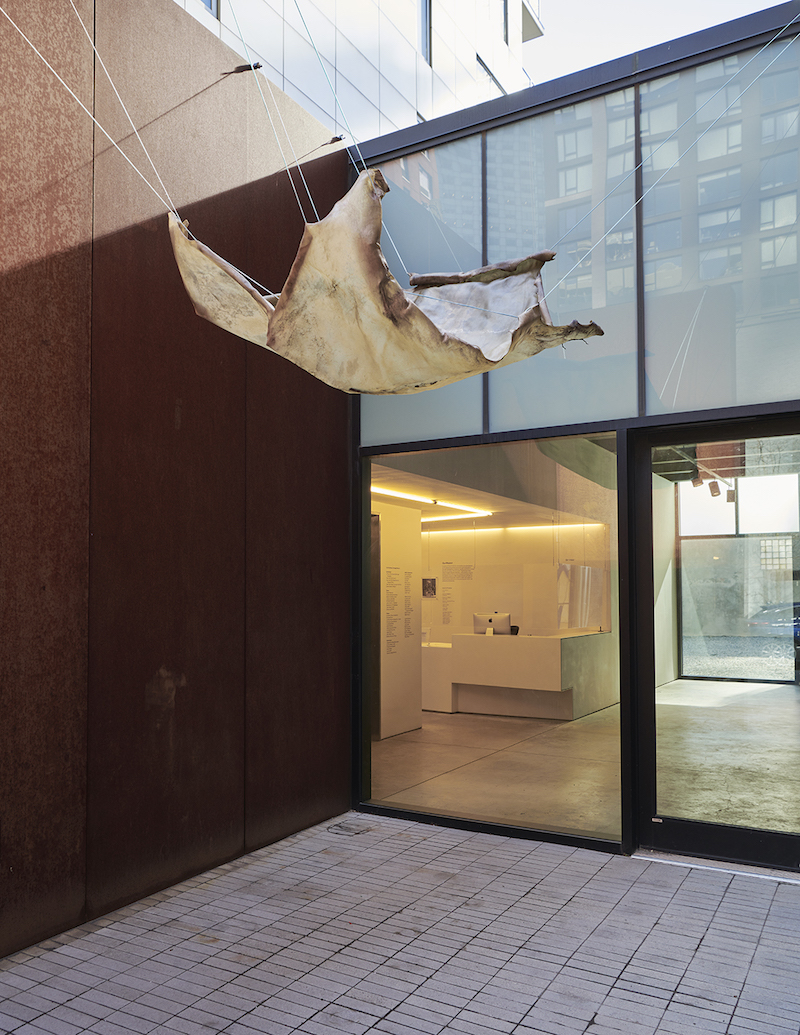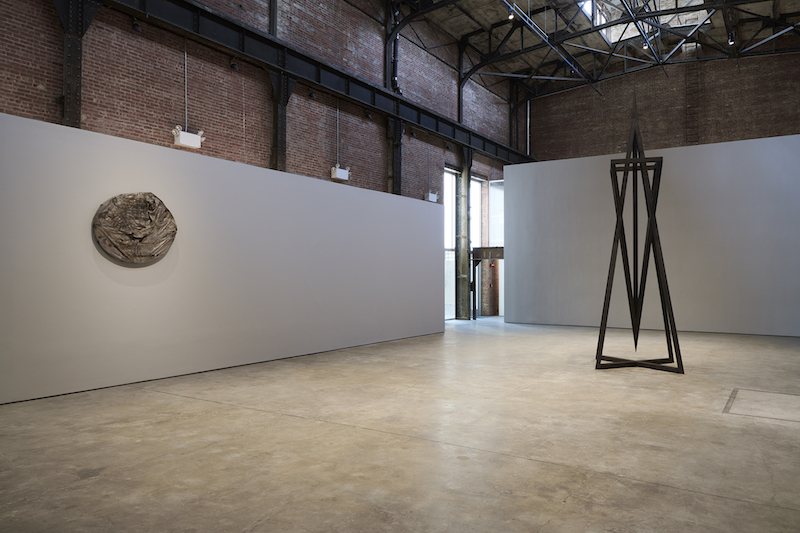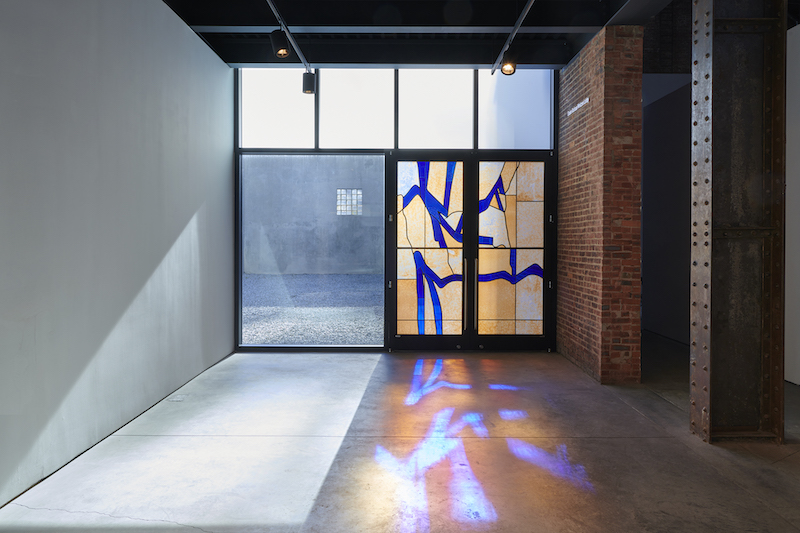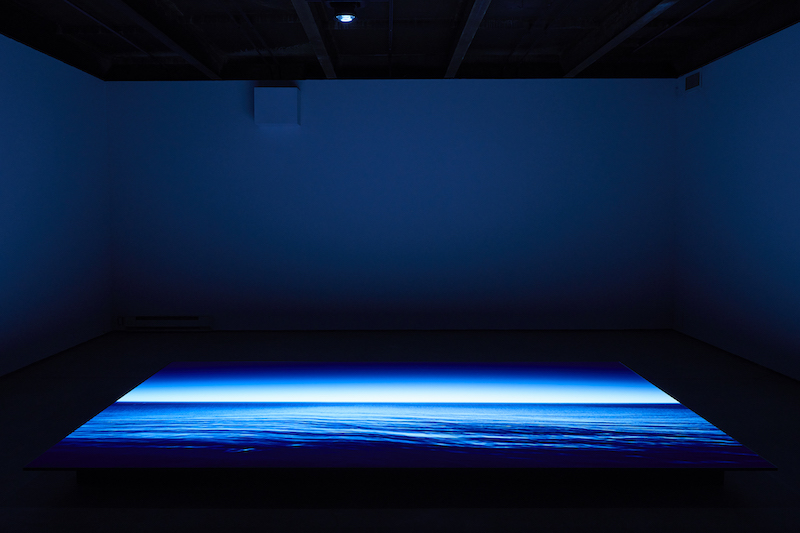by Nora Kovacs // July 13, 2021
Rindon Johnson moves seamlessly from clarity to abstraction, and back again. As a multidisciplinary artist, writer and poet, he finds the slippery border between language and form, bringing it to our attention before collapsing it entirely. ‘Law of Large Numbers: Our Bodies,’ Johnson’s first solo museum exhibition at SculptureCenter in New York, distills a year of research, conversations, fears and frustrations into a series of newly-commissioned sculptures, a video work and a publication. The exhibition comes out of a period of isolation and upheaval; the relatively bare spaces of SculptureCenter recalling the deafening silence that the early days of the pandemic brought with it. Stuck in Berlin throughout the ensuing quarantines and lockdowns, Johnson’s anxieties regarding the spread of the virus, rising death tolls and the disparities that were both revealed and exacerbated by the ongoing global health crisis are woven throughout ‘Law of Large Numbers: Our Bodies.’ The exhibition documents the processes of disembodiment and alienation that have characterized the past year, tracing the fraught relationship between our bodies and the systems that both protect and confine them.

Rindon Johnson: ‘For example, collect the water just to see it pool there above your head. Don’t be a Fucking Hero!,’ 2021–ongoing. Rawhide, paracord, rainwater // Courtesy the artist and Ghebaly Gallery, Los Angeles, Photo by Kyle Knodell
A rawhide hangs from a paracord at the entrance to SculptureCenter, its edges curling inwards and recoiling from the taut threads that bear its weight. The work, titled ‘For example, collect the water just to see it pool there above your head. Don’t be a Fucking Hero!’ (2021-ongoing), filters light from the sky above, giving its brownish yellow skin an almost translucent hue. A pool of rainwater accumulates in a small nook of the skin and on the ground below it, as small insects and flies hover around the musty, stagnant liquid. The work appears to float mid-air while simultaneously being pulled down by gravity, growing heavier and heavier with the passing of time.
“A pronoun is a leaky container,” Johnson writes in the exhibition’s accompanying publication, “poorly constructed, with a terrible warranty.” The artist highlights the inadequacies of the structures and laws that dictate how we move through public space. Language, like the body, attempts to delineate parameters; to separate one thing from another. Yet, as Johnson points out, it inherently fails to do so. Something is always bound to spill over or seep out. The artist thereby gives physical presence to that which is absent. Whether it be the degradation of the exhibition’s content or the sprawling titles assigned to each work, Johnson’s recent body of work continues to stretch, unfurl, leak and harden as we move throughout the exhibition.

Rindon Johnson: ‘Law of Large Numbers: Our Bodies,’ installation view, SculptureCenter, New York, 2021 // Photo by Kyle Knodell
‘A Round, Solid figure, it has occurred to me that I exercise to make myself cheaper for my insurance company, I mean for myself, Anthem, noun a song of loyalty or devotion, sung antiphonally, sung recited or played, the sung sun asunder, alternatively, the sun sung asunder, is this now, stand by yourself then, in or into a separate place, Solid figure, we’re up all night, it has occurred to me that I exercise to make myself cheaper for my insurance company, I mean for myself, Anthem, we decided a group of us, a noun a song of loyalty or devotion, sung antiphonally, sung recited or played, the sung sun asunder, alternatively, the sun sung asunder, is this now, stand by yourself then, in or into a separate place, Solid figure can we go to the woods now? Let’s stay out of all things together, apart.’ (2018–ongoing) evokes a similarly visceral response. Made with indigo dye, coffee, rust, bleach and leather stretched over an oval-shaped plywood panel, the work is tired, crumpled and sagging. Like ‘For example…’ (2021–ongoing), it has been warped and manipulated into holding a particular shape, despite the resistance of its materiality to do so.
“A few months later, I grow impatient.” Johnson writes of the process of making ‘A Round…’ “I pour shellac over all of it. I destroy it. I fix it. It can’t be fixed, I destroy it again, I dry cry about it, I drink a Manhattan at the pizza place, I have a big fit and watch period films, I flip it upright, I flip it over. I wait. I pour more shellac over it. I wait. I destroy it. It can’t be destroyed. Another fit. I put Vaseline on it. I wait. I fix it. I bleach it. I wait again…The pandemic happens. I commit myself to showing it. I don’t see it for a year.” The work is thereby charged with a certain honesty. It reveals the artist’s impatience, dissatisfaction, restlessness and anxiety. Like canyons or caves eroding over time, ‘A Round…’ bears the scars of its past. It cannot be fixed and it cannot be destroyed; it is ongoing, and this is what it looks like today.

Rindon Johnson: ‘Floating through the canyon, through the canyon, through the canyon, the Peace of Martial Law, the PEACE of Martial Law, the canyon walls are 2000 feet high, 2000 feet high, 2000 feet high, some rose-colored glasses, some rose-colored glasses, it is only a matter of time. No, this thing and not the other thing either. CREEK! It’s only a matter of time. Find me inside, many of us were scared, but after they ate a pizza from the backpack of a man who was taking a swim, they were looking for dessert. They found the bag and decided to take it away,’ 2021, Rose Brooks leaded stained glass // Courtesy the artist and Ghebaly Gallery, Los Angeles, Photo by Kyle Knodell
Standing in juxtaposition to this fluidity is ‘Coeval Proposition #1: Tear down so as to make flat with the Ground or The *Trans America Building Dismantle Everything’ (2021–ongoing). The sculpture reimagines the Transamerica Pyramid, the second tallest building in the San Francisco skyline. As an emblem of life insurance and financial investment, as well as a recognizable symbol of the artist’s hometown, the white quartz building conjures questions around belonging and the infrastructures that measure one person’s worth or legitimacy over another’s. Johnson renders his version of the building in ebonized redwood, giving it a sharp and spindly quality, almost like a pyre. ‘Coeval Proposition #1’ includes not one, but two pyramids, one of which is placed upside down inside of the other. Through this action, the artist not only flips the notion of a Transamerica building (literally) on its head, but strikes some sort of balance that is missing for its original form. What if this image of capitalist, patriarchal society were actually a monument to trans life, histories and liberation?
“There is never really a settling, the building of a house, the construction of a garden, the tilling of land with the same crops each season. You cannot build a house in gender,” Johnson writes. “Rather, Trans is a wave, cresting, retreating, arriving again. The catharsis of transition is not climbing up onto a sand bank, rather it is the breaking of a wave in the middle of the sea, capping, all inner whims, cresting, bubbles in aggregate only to be simultaneously forming again.” The artist not only re-appropriates the Transamerica building to reflect his own identity, but questions the very existence of constructs, both physical and social. These rigid structures and ongoing attempts to encompass, control and contain are inherently in conflict with what it means to inhabit this world; to learn, shift and adapt from one moment to the next.

Rindon Johnson: ‘Coeval Proposition #2: Last Year’s Atlantic, or You look really good, you look like you pretended like nothing ever happened, or a Weakening,’ 2021, Realtime Portrait Animating Program, projectors, platform, computer // Courtesy SculptureCenter, New York and Chisenhale Gallery, London Ghebaly Gallery, Los Angeles, Photo by Kyle Knodell
As much as ‘Law of Large Numbers: Our Bodies’ is an exploration of the limitations of language, it is therefore also an exercise in the poetics of space. How does language inform our actions? What bearings do built environments have on our thoughts and perceptions? By obscuring the distinction between material and immaterial infrastructures, Johnson unravels the architectures of our minds and the beliefs that we embody. “To be born at all is to be situated in a network of relations with other people,” Olivia Laing describes in ‘Everybody: a Book about Freedom,’ “…to find oneself forcibly inserted into linguistic categories that might seem natural and inevitable but are socially constructed and rigorously policed. We’re all stuck in our bodies, meaning stuck inside a grid of conflicting ideas about what those bodies mean, what they’re capable of and what they’re allowed or forbidden to do.” These are the same intricate networks and relations that submerge and resurface throughout ‘Law of Large Numbers: Our Bodies.’ Emerging at a moment when every breath, movement and interaction suddenly felt amplified, the exhibition lays bare the internalized norms and conditions that we mold ourselves into and around; that shape not only how we move through the present but what we are capable of imagining for the future.
This article is part of our feature topic of ‘Poetics.’ To read more from this topic, click here.
Exhibition Info
SculptureCenter
Rindon Johnson: ‘Law of Large Numbers: Our Bodies’
Exhibition: Mar. 25–Aug. 2, 2021
sculpture-center.org
44–19 Purves Street, Long Island City, NY 11101, click here for map




















